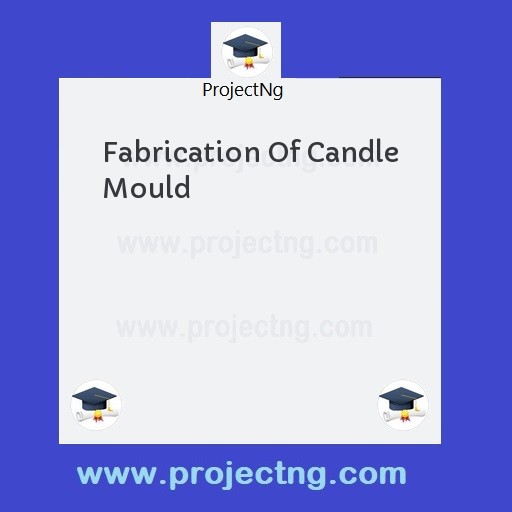Fabrication Of Candle Mould
Chemical Engineering Project Topics
Get the Complete Project Materials Now! »
FABRICATION OF CANDLE MOULD
ABSTRACT
This project aims at fabricating a functional and durable candle mould with twelve holes or cavities which could be used for the production of candle. It also aims at helping the participants to gain a first hand reality knowledge of fabricating a candle mould. The materials used were locally sourced and selected to suit the purpose. The most affordable and available material was used, that is aluminum.
The fabrication of this work was carried out in sequential process or order namely, pattern making, which is the making of the prototype, mould dressing which is the making of a sand bed in which the pattern will be embedded so as to imprint the desired design on the molding sand. Melting, this is heating of the aluminum to its molten state. Casting, this is the pouring of the molten aluminum into the mould. Shake-out, is the removal of the solidified aluminum casted and finishing which is the final touch given to the candle mould, to give it an appealing look. In the process of fabrication, the following tools were used, bellows, ladles, crucibles, grinding machine, hack saw and lathe. The dimensions made used of for the fabrication of the candle mould are: length of each cavity is 195mm, Diameter of each cavity is 13.2mm, thickness of the entire mould is 43.7mm, and width of the candle mould is 22mm while its length is 360mm.
At the end of the fabrication process, a functional candle mould of 12 cavities was produced. It also availed us the undertaking students the opportunity of learning the processes involved in the production of a functional candle mould for small scale production of candle.
TABLE OF CONTENTS
Title page i
Letter of Transmittal ii
Certification iii
Dedication iv
Acknowledgement v
Abstract vi
Table of Contents vii
CHAPTER ONE
INTRODUCTION 1
1.1 Background of study 1
1.2 Statement of the problem 2
1.3 Aims/purpose of study 3
1.4 Method of research 3
1.5 Significance of the study 4
CHAPTER TWO
LITERATURE REVIEW 5
CHAPTER THREE
Methodology/constructional 30
CHAPTER FOUR
RESULT ANALYSIS 35
CHAPTER FIVE
5.1 Discussion 37
5.2 Conclusion 40
5.3 Recommendation 41
References 42
CHAPTER ONE
INTRODUCTION
1.6 BACKGROUND OF STUDY
Moulds are sold to be as old as man, the early days blacksmiths were able to construct, forge and design materials of different shapes and sizes using moulds. Now, moulds are widely used industries and manufacturing establishment to produce materials with different shapes, pattern, embossment etc.
A mould is said to be a pattern constructed for the production of a materials of a material of a desired shape of the same prototype. In other words, mould is a designed equipment that has the shape of the material to be produced. After production, the substance usually in molten form, power into the mould, takes the shape of the mould on solidification. Moulds are usually used in industries that deals with paste and liquid like materials that solidify on cooling. Moulds have diverse applications; this diversity in application gives rise to the need for designing and the development of moulds with different materials, compositions, shapes, textile and corrosion resistance.
In fabrication of candle mould, metal (Aluminum) is the preferred material used in fabrication of the mould. Metals are generally the best materials for fabrication of moulds. To fabricate moulds, it involves the process of casting; Casting is the process of forming metal into moulds of desired shape. Aluminum is the selected material due to the fact that it has lots of advantages.
1.7 STATEMENT OF THE PROBLEM
There is a wide application of moulds in different disciplines or professions in the society such as its application in the food industries, electrical fields, etc. The fabrication of a candle mould requires a particular sequence of operations such as casting, cutting, machining, designing, patterning filling etc. This sequence of operations is characterized with skills and techniques. Thus, as a student fabricating of a candle mould, there is need to be acquainted with necessary skills, knowledge, techniques and procedures that underlined the fabrication process involved in the production of a candle mould.
1.8 AIMS/PURPOSE OF STUDY
The basic purpose of this study is to
i) To highlight the basic processes involved in the fabrication of a candle mould.
ii) To fabricate an efficient candle mould that will produce a smooth, marketable candle.
iii) To acquire the fabrication techniques and skills.
1.9 METHOD OF RESEARCH
The method of research involves the collection of relevant material from variety of texts gotten from the library and consultation of the internet. Professionals were also consulted and data’s gotten from the fabrication site.
1.10 SIGNIFICANCE OF THE STUDY
- To be familiarized with the basic processes of fabrication of a candle mould
- To obtain a first hand reality experience
- To contribute effectively to industrial development
Be the First to Share On Social

Enjoying our content?
Don't miss out on new videos! Subscribe to our YouTube channel for more awesome content.
Subscribe Now!













